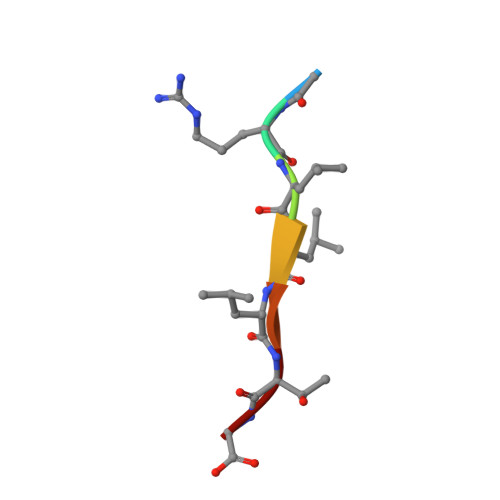Crystal structure of the stress-inducible human heat shock protein 70 substrate-binding domain in complex with Peptide substrate.
Zhang, P., Leu, J.I., Murphy, M.E., George, D.L., Marmorstein, R.(2014) PLoS One 9: e103518-e103518
- PubMed: 25058147
- DOI: https://doi.org/10.1371/journal.pone.0103518
- Primary Citation of Related Structures:
4PO2 - PubMed Abstract:
The HSP70 family of molecular chaperones function to maintain protein quality control and homeostasis. The major stress-induced form, HSP70 (also called HSP72 or HSPA1A) is considered an important anti-cancer drug target because it is constitutively overexpressed in a number of human cancers and promotes cancer cell survival. All HSP70 family members contain two functional domains: an N-terminal nucleotide binding domain (NBD) and a C-terminal protein substrate-binding domain (SBD); the latter is subdivided into SBDα and SBDβ subdomains. The NBD and SBD structures of the bacterial ortholog, DnaK, have been characterized, but only the isolated NBD and SBDα segments of eukaryotic HSP70 proteins have been determined. Here we report the crystal structure of the substrate-bound human HSP70-SBD to 2 angstrom resolution. The overall fold of this SBD is similar to the corresponding domain in the substrate-bound DnaK structures, confirming a similar overall architecture of the orthologous bacterial and human HSP70 proteins. However, conformational differences are observed in the peptide-HSP70-SBD complex, particularly in the loop L(α, β) that bridges SBDα to SBDβ, and the loop L(L,1) that connects the SBD and NBD. The interaction between the SBDα and SBDβ subdomains and the mode of substrate recognition is also different between DnaK and HSP70. This suggests that differences may exist in how different HSP70 proteins recognize their respective substrates. The high-resolution structure of the substrate-bound-HSP70-SBD complex provides a molecular platform for the rational design of small molecule compounds that preferentially target this C-terminal domain, in order to modulate human HSP70 function.
- Program in Gene Expression and Regulation, The Wistar Institute, Philadelphia, Pennsylvania, United States of America; Department of Biochemistry & Biophysics, Abramson Family Cancer Research Institute, Perelman School of Medicine at the University of Pennsylvania, Philadelphia, Pennsylvania, United States of America.
Organizational Affiliation:



















